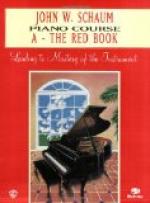Matthay believes, and rightly, that the beginning pupil should learn essentials of note values, rhythm, time, ear-training and so on, before attempting to play anything at the piano. When first taken to the instrument, its mechanism is carefully explained to the learner, and what he must do to make a really musical tone. He says (Child’s First Steps): “Before you take the very first step in tone production, be sure to understand that you must never touch the piano without trying to make music. It is only too easy to sound notes without making music at all. To make music we must make all the sounds mean something, just as it is no use to pretend to speak unless the sounds we make with our lips mean something, that is unless they form reasoned phrases and sentences.”
Here nothing is left vague. Matthay shows clearly how all musical Form and Shape imply Movement and Progression: the movement of a phrase toward its cadence; the movement of a group of notes toward a beat or pulse ahead, or the movement of a whole piece toward its climax, etc. This original view of his regarding form, which he has advocated for the last twenty years, is now being accepted generally by the more up-to-date of the English theorists and teachers.
In regard to key mechanism and what must be done to produce all varieties of touch and tone, Matthay has made exhaustive studies. He says (First Principles of Piano Playing): “The two chief rules of technic, as regards the key, are, therefore: Always feel how much the key resists you: feel how much the key wants for every note. Second, Always listen for the moment each sound begins, so that you may learn to direct your effort to the sound only, and not to the key bed. You must never hit a key down, nor hit at it. The finger-tip may fall on the key, and in gently reaching the key you may follow up such fall by acting against the key. This action against the key must be for the sole purpose of making it move—in one of the many ways which each give us quite a different kind of sound. And you must always direct such action to the point in key descent where the sound begins.”
I quote also this little summary from the same work:
“(a) It is only by making the hammer-end of the key move that you can make a sound. (b) The swifter the movement the louder the sound. (c) The more gradual this swiftness is obtained the more beautiful the quality of sound. (d) For brilliant tone you may hit the string by means of the key, but do not, by mistake, hit the key instead. (e) You must ‘aim’ the key to the beginning of each sound, because the hammer falls off the string as you hear that beginning, and it is too late then to influence the sound except its continuance. (f) It is wrong to squeeze the key beds, because it prevents tone, impairs musical result, impedes agility, and is, besides, fatiguing. (g) You must feel the ’giving way point’ of the key, so that you may be able to tell how much force is required for each note. Never, therefore, really hit the keys.”




